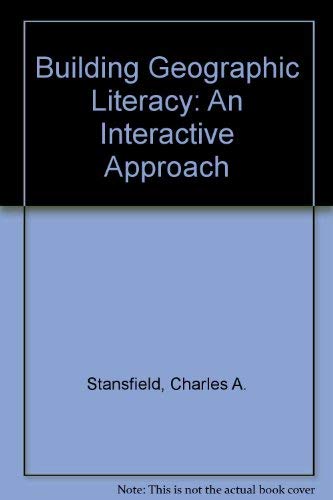Items related to Building Geographic Literacy: An Interactive Approach

"synopsis" may belong to another edition of this title.
Building Geographic Literacy is a workbook. It will involve you in creating maps, applying geographic principles, and learning basic place geography. Multiple copies of blank outline maps are provided for you to complete by correctly locating and labeling placenames. You will need to refer to an atlas or to maps in a geography textbook to supply the place locations that you identify on the outline maps.
In this new edition, all demographic, economic and cultural statistics have been updated as of the most recent data available at publication. This edition contains eight new tables and an additional 60 questions. There are seven new maps on which students are asked to enter data and interpret resulting patterns. Extra copies of regional and world maps are provided in Appendix B for the convenience of students wishing to redo maps and to enable instructors to assign map exercises of their own choice.
This workbook can be used with any standard world atlas or geography textbook. The placenames selected for placement and labeling on the outline maps are those most likely to appear on textbook maps and are commonly cited in geography texts.
Although the spelling of placenames reflects standard usage, some books and atlases may use slightly different transliterations from foreign languages, particularly Chinese and Arabic. These minor variations are not significant and will not interfere with the utility of this workbook.
You will be asked to apply your newly acquired knowledge of placename geography, and thus reinforce that knowledge, by making thematic maps. Thematic maps communicate qualities or characteristics or places in addition to providing place information. These qualities maybe physical, economic, cultural, or political factors that vary geographically, that is, across space. For example, you will be making maps of population growth rates and per capita gross national product for countries in various regions.
This workbook is interactive, that is, you are asked to write answers, label maps, and make maps in the workbook itself as you go along. You will be studying placename geography by making placename maps, and by constructing thematic maps that apply placename comprehension to other geographic questions and concepts.
The first chapter explains the importance of knowing placename geography. Chapter 2 reviews Earth's location grid, the lines of latitude and longitude, and examines time zones and the International Date Line. The place geography of the continents, major islands, and oceans and seas is outlined in Chapter 3, which includes a glossary of important land and water features.
Chapters 4 to 13 comprise 10 regional chapters, each studying a major subdivision of Earth's lands and nations. Each chapter begins with an introduction to the region, followed by a survey of its important physical geography features. "Objectives and Study Hints" highlight the significance of the geography of countries and peoples of the region, followed by a review of the region's political, economic, and cultural geography and regional demographics—the size, make up, and growth rates of its population. "Check Up" questions then test your geographic understanding of the region. Each chapter then summarizes one or two important geoconcepts related to the places just studied. Some chapters include an optional "Special Challenge"—an exercise that focuses your attention on a somewhat more complex geographic project or problem.
That geography is a dynamic subject has been demonstrated amply by the many boundary changes since the first edition. Chapter 6, initially titled "The USSR: The Devolution of Empire," has been rewritten completely. Further boundary changes in Europe—the fragmentation of Yugoslavia and the split of Czechoslovakia—also have been incorporated in maps and tables. Eritrea's secession from Ethiopia has been noted as well. Canada's 2000 creation of a new territory, Nunavut, has been noted on all maps of Canada and North America. The pace of boundary changes may slow, but future changes are likely in several regions. A concluding section, "Regional Watchlist," comments briefly on potential boundary changes one should be alert to after this edition goes to press.
It is important to note that, although the 10 major world regions used here are widely accepted by geographers, there are no right or wrong systems of regionalization. Regions are identified and bounded by geographers to facilitate geographic study. A region has some degree of internal similarity, and areas beyond it are characterized by different qualities. There are many possible, logical, and useful regionalization schemes because there are many different geographic criteria for describing regions. This workbook can be used with a variety of textbook regional systems.
I would like to thank my colleague Edward Behm at Rowan University for his many perceptive comments on the first edition. Professor W. Frank Ainsley, University of North Carolina at Wilmington; Richard Dixon, Southwest Texas State University; and Michael P. Peterson, University of Nebraska at Omaha, contributed many useful comments on the third edition. I appreciate their diligent and perceptive criticisms.
This fourth edition clearly has benefitted from the superbly professional and efficient efforts of Dan Kaveney, Executive Editor. Once again, thanks to Paul Corey for his enthusiastic support of the original concept. I'd like to thank Megan Hill for her thorough copyediting, and the staff of Lithokraft II for their careful formatting. Mapquest prepared the new maps required by this edition, and redrafted many other base maps. Charles A. Stansfield, Jr.
Rowan University of New Jersey
"About this title" may belong to another edition of this title.
- PublisherPrentice Hall
- ISBN 10 0024156604
- ISBN 13 9780024156600
- BindingPaperback
- Edition number2
Buy New
Learn more about this copy
Shipping:
US$ 4.49
Within U.S.A.
Top Search Results from the AbeBooks Marketplace
Building Geographic Literacy: An Interactive Approach
Book Description Soft cover. Condition: New. Shows some light shelfwear. A workbook that involves you in creating maps, applying geographic principles, and learning basic place geography. Provides Exercises, Study Hints, and work pages. Seller Inventory # 4772-1

